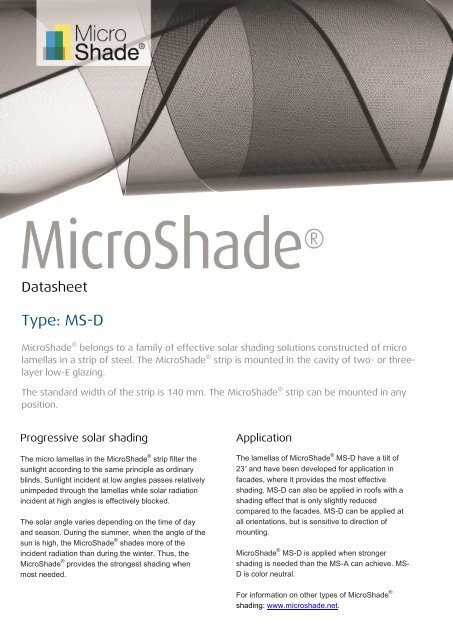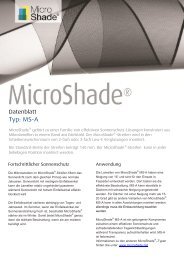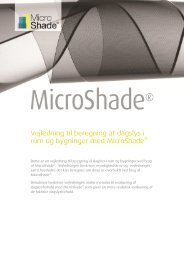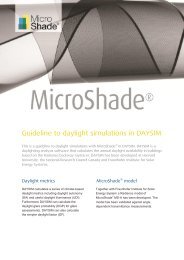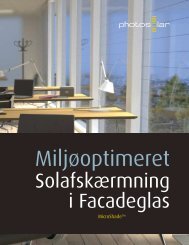Type: MS-D - MicroShade⢠Solar shading solar control sun protection
Type: MS-D - MicroShade⢠Solar shading solar control sun protection
Type: MS-D - MicroShade⢠Solar shading solar control sun protection
Create successful ePaper yourself
Turn your PDF publications into a flip-book with our unique Google optimized e-Paper software.
Datasheet<br />
<strong>Type</strong>: <strong>MS</strong>-D<br />
MicroShade ® belongs to a family of effective <strong>solar</strong> <strong>shading</strong> solutions constructed of micro<br />
lamellas in a strip of steel. The MicroShade ® strip is mounted in the cavity of two- or threelayer<br />
low-E glazing.<br />
The standard width of the strip is 140 mm. The MicroShade ® strip can be mounted in any<br />
position.<br />
Progressive <strong>solar</strong> <strong>shading</strong><br />
The micro lamellas in the MicroShade ® strip filter the<br />
<strong>sun</strong>light according to the same principle as ordinary<br />
blinds. Sunlight incident at low angles passes relatively<br />
unimpeded through the lamellas while <strong>solar</strong> radiation<br />
incident at high angles is effectively blocked.<br />
The <strong>solar</strong> angle varies depending on the time of day<br />
and season. During the summer, when the angle of the<br />
<strong>sun</strong> is high, the MicroShade ® shades more of the<br />
incident radiation than during the winter. Thus, the<br />
MicroShade ® provides the strongest <strong>shading</strong> when<br />
most needed.<br />
Application<br />
The lamellas of MicroShade ® <strong>MS</strong>-D have a tilt of<br />
23˚ and have been developed for application in<br />
facades, where it provides the most effective<br />
<strong>shading</strong>. <strong>MS</strong>-D can also be applied in roofs with a<br />
<strong>shading</strong> effect that is only slightly reduced<br />
compared to the facades. <strong>MS</strong>-D can be applied at<br />
all orientations, but is sensitive to direction of<br />
mounting.<br />
MicroShade ® <strong>MS</strong>-D is applied when stronger<br />
<strong>shading</strong> is needed than the <strong>MS</strong>-A can achieve. <strong>MS</strong>-<br />
D is color neutral.<br />
For information on other types of MicroShade ®<br />
<strong>shading</strong>: www.microshade.net.
Technical data for MicroShade ® glazing<br />
Construction<br />
MicroShade ® glazing is dimensioned in<br />
accordance with current standards. MicroShade ®<br />
glazing can be supplied in standard two- or threelayer<br />
glazing constructions.<br />
External glass: Tempered<br />
U- value<br />
<strong>Type</strong><br />
U-value (W/m²K)<br />
2-layer <strong>MS</strong>-D, (4-16-4) 1.1<br />
3-layer <strong>MS</strong>-D, (4-12-4-12-4) 0.7<br />
Internal glass: Normally supplied with low-E float<br />
glass. Tempered or laminated low-E glass can be<br />
delivered if specified.<br />
Spacer: Warm edge, stainless steel or similar.<br />
Gas filling: Argon<br />
Light- & <strong>solar</strong> energy transmittance<br />
The light transmittance indicates the ratio between the<br />
volume of transmitted daylight through the window and the<br />
amount of incident daylight on the window. The daylight is<br />
defined by the radiation distribution of illuminant D65<br />
(EN410:1998).<br />
The direct <strong>solar</strong> energy transmittance through a window is<br />
defined as the ratio between the transmitted and incident<br />
<strong>solar</strong> energy on the window.<br />
The total <strong>solar</strong> energy transmittance or g-value (<strong>solar</strong> factor)<br />
is calculated as the sum of the transmitted <strong>solar</strong> radiation and<br />
the transmitted heat contribution divided by the incident <strong>solar</strong><br />
energy on the window.<br />
A low g-value indicates strong <strong>solar</strong> <strong>shading</strong> and a high g-<br />
value indicates weaker <strong>shading</strong>.<br />
For MicroShade ® the light transmittance and g-value of the<br />
glazing change with the incident angle of the <strong>solar</strong> radiation:<br />
At low radiation angles MicroShade ® allows a high<br />
transmittance while the transmittance is low at higher angles.
Optical properties<br />
– two-layer MicroShade ® glazing<br />
The tables show the g-value, the direct <strong>solar</strong><br />
energy transmittance and the daylight<br />
transmittance for MicroShade ® glazing at selected<br />
angles of incidence.<br />
The data shown is valid for two-layer glazing with<br />
MicroShade ® type <strong>MS</strong>-D.<br />
Table 1:<br />
g-values<br />
Azimuth<br />
(degrees)<br />
<strong>Solar</strong> hight (degrees)<br />
0 15 30 45 60 75<br />
0 0.35 0.31 0.25 0.18 0.07 0.03<br />
15 0.35 0.30 0.25 0.17 0.06 0.03<br />
30 0.32 0.28 0.23 0.15 0.05 0.03<br />
45 0.28 0.24 0.19 0.12 0.04 0.02<br />
60 0.18 0.16 0.12 0.06 0.03 0.02<br />
75 0.03 0.03 0.03 0.02 0.02 0.01<br />
The construction of the glazing<br />
4 mm Planilux + MicroShade ® <strong>MS</strong>-D + 4 mm<br />
Planitherm Ultra N II with argon filling from Saint<br />
Gobain (Calumen II).<br />
All optical data is calculated according to EN<br />
410:1998.<br />
Table 2:<br />
<strong>Solar</strong> direct<br />
transmittance<br />
Azimuth<br />
(degrees)<br />
<strong>Solar</strong> hight (degrees)<br />
0 15 30 45 60 75<br />
0 0.30 0.26 0.20 0.13 0.03 0.00<br />
15 0.29 0.25 0.20 0.13 0.03 0.00<br />
30 0.27 0.23 0.18 0.11 0.02 0.00<br />
45 0.22 0.19 0.14 0.08 0.01 0.00<br />
60 0.14 0.11 0.08 0.03 0.00 0.00<br />
75 0.00 0.00 0.00 0.00 0.00 0.00<br />
Table 3:<br />
Light<br />
transmittance<br />
<strong>Solar</strong> hight (degrees)<br />
0 15 30 45 60 75<br />
0 0.43 0.36 0.29 0.19 0.04 0.00<br />
15 0.42 0.36 0.28 0.18 0.04 0.00<br />
Azimuth<br />
(degrees)<br />
30 0.38 0.33 0.26 0.16 0.03 0.00<br />
45 0.32 0.27 0.21 0.11 0.01 0.00<br />
60 0.20 0.16 0.11 0.04 0.00 0.00<br />
75 0.00 0.00 0.00 0.00 0.00 0.00
Optical properties<br />
– three-layer MicroShade ® glazing<br />
The tables show the g-value, the direct <strong>solar</strong><br />
energy transmittance and the daylight<br />
transmittance for MicroShade ® glazing at selected<br />
angles of incidence.<br />
The data shown is valid for three-layer glazing with<br />
MicroShade ® type <strong>MS</strong>-D.<br />
Table 4:<br />
g-values<br />
Azimuth<br />
(degrees)<br />
<strong>Solar</strong> height (degrees)<br />
0 15 30 45 60 75<br />
0 0.31 0.26 0.21 0.14 0.04 0.01<br />
15 0.30 0.26 0.21 0.14 0.04 0.01<br />
30 0.28 0.24 0.19 0.12 0.03 0.01<br />
45 0.23 0.20 0.15 0.09 0.02 0.01<br />
60 0.14 0.12 0.08 0.03 0.01 0.01<br />
75 0.01 0.01 0.01 0.01 0.01 0.01<br />
The construction of the glazing<br />
4 mm Planilux + MicroShade ® <strong>MS</strong>-D + 4 mm<br />
Planitherm Ultra N II + 4 mm Planitherm Ultra N II<br />
with argon filling from Saint Gobain (Calumen II).<br />
Table 5:<br />
<strong>Solar</strong> direct<br />
transmittance<br />
<strong>Solar</strong> height (degrees)<br />
0 15 30 45 60 75<br />
0 0.23 0.20 0.15 0.10 0.02 0.00<br />
15 0.22 0.19 0.15 0.09 0.02 0.00<br />
All optical data is calculated according to EN<br />
410:1998.<br />
Azimuth<br />
(degrees)<br />
30 0.21 0.18 0.14 0.08 0.01 0.00<br />
45 0.17 0.14 0.10 0.05 0.00 0.00<br />
60 0.09 0.08 0.05 0.02 0.00 0.00<br />
75 0.00 0.00 0.00 0.00 0.00 0.00<br />
Table 6:<br />
Light<br />
transmittance<br />
<strong>Solar</strong> height (degrees)<br />
0 15 30 45 60 75<br />
0 0.38 0.32 0.26 0.16 0.04 0.00<br />
15 0.37 0.32 0.25 0.16 0.03 0.00<br />
Azimuth<br />
(degrees)<br />
30 0.34 0.29 0.22 0.13 0.02 0.00<br />
45 0.28 0.24 0.18 0.09 0.01 0.00<br />
60 0.16 0.13 0.08 0.03 0.00 0.00<br />
75 0.00 0.00 0.00 0.00 0.00 0.00
Color rendering index<br />
The color rendering of transmitted light through the<br />
MicroShade ® <strong>MS</strong>-D is neutral.<br />
Color rendering index for MicroShade ®<br />
by normal incident light:<br />
Color 1 2 3 4 5 6 7 8<br />
Ra 99,8 99,7 99,5 99,6 99,5 99,2 99,5 99,7<br />
The color rendering index is calculated according<br />
to EN 410:1998 by assessing the color rendering<br />
of eight different color standards illuminated with a<br />
standard light source through the window.<br />
The color rendering is measured on a scale from 0<br />
to 100, with100 as the best (neutral) and the<br />
overall index is the average of the eight. According<br />
to EN 410:1998 a color rendering index above 90<br />
indicates high color neutrality.<br />
All information is intended as guidance.<br />
MicroShade A/S reserves the right to make<br />
amendments and changes to product<br />
specifications. MicroShade A/S cannot be held<br />
responsible for the correctness of the information.<br />
MicroShade A/S<br />
Gregersensvej 1F<br />
2630 Taastrup<br />
Denmark<br />
Tel: +45 7214 4848<br />
info@microshade.net<br />
www.microshade.net


